New-generation Camry adds sporty side
By John Gilbert
It’s not often anyone mentions “Camry” and “sporty” in the same story, let alone the same sentence, but here goes: The newest revision of Toyota’s iconic sedan comes close to offering all things to all buyers — including a major advancement in real-world sportiness.
The 2012 Toyota Camry, in middle-model trim, offers a 2.5-liter 4-cylinder with its 6-speed automatic transmission augmented by fingertip paddles on the steering wheel to facilitate manually overriding the automatic. The Honda Accord, forever Camry’s biggest competitor, and universally considered sportier and peppier, doesn’t offer either a 6-speed automatic and much less paddles.
Such devices aren’t necessarily earth-shaking these days, with other sporty sedans making them readily available, and Toyota’s 6-speed automatic is not new, but the paddles allow Toyota to emerge onto that plateau of useful sportiness without fanfare. Which might be too bad, because a lot of buyers who have grown used to criticism of the Camry might add it to their list of considerations if they knew of such a bold upgrade.
Success in the automobile world often leads to criticism, and the Camry has undergone its share of both. Since the Camry took over as the No. 1 selling car in the U.S., critics have sniped at it for being as boring as a kitchen appliance, devoid of character, sportiness, or even style. Much of the criticism had a foundation, because Toyota grew more conservative with the Camry as its popularity grew. Toyota was so intent on building a car for the masses, for those who aren’t interested in spirited driving, and maybe even for those who find driving a drudgery and just want a trouble-free conveyance from Point A to Point B, that it seemed to round off the Camry’s edges in more ways than just styling. If you have enough support to sell more Camrys than anybody else sells any competitor, then why worry about the fringe hot-rodders? On the other hand, why not capture them, too?
It was easy to subscribe to much of the criticism, except I thought Toyota kept the styling contemporary with each new model, and while unobtrusive, it never was mediocre looking or dull in appearance. I also believed that while it seemed softer and less performance-oriented than the Accord, Altima, Mazda6, or Fusion, there was something to be said on behalf of those who drive the real world in a far more mild manner than those of us who road-test cars and push them to limits normal folks wouldn’t think of.
The new Camry is subtle in its redesign, and feels firmer in its handling and quicker in steering response. In styling, there is a very neat crease running along the upper edge of the body contour, which the designers like to call a car’s shoulder. It creates a neat edge that gives the Camry a first-impression look that is not unlike the Acura TSX in attractiveness. A new grille, and modified rear give the exterior an attractive upgrade. Read more
Volt loses volts as weather chills out
By John Gilbert
The morning after I inadvertently left my pocket camera in the car outside overnight, when it was 10-below zero, I spotted the camera and turned it on, and a little red light flashed to warn me that my fully-charged battery was down to zero. I slid the camera into an inside pocket of my down parka, and went on my way.
A couple of hours later, I turned on the camera again, and — as if by magic — found that my body heat had rejuvenated the battery to full status. I was impressed at its powers of recovery, and immediately, I wondered what would happen to the battery pack in a Chevrolet Volt in the same weather.
I had been test-driving a Chevrolet Volt a few weeks earlier, when it seemed as though we were going to have a winter with no snow or cold in Northern Minnesota. The Volt, of course, is Chevy’s impressive experiment at making a plug-in electric car, with a separate gas-engine for backup. I wondered how severe cold might reduce the Volt’s battery-powered drive from its 50-mile range.
The comparatively winterless winter has seemed strange in Northern Minnesota, because even the occasional snowstorms that have hit Minneapolis and most of Wisconsin haven’t reached as far as the tip of Lake Superior. In fact, this year’s John Beargrease Dogsled Marathon from Duluth up the North Shore and back has been cancelled because of a lack of snow. A dogsled is about the only vehicle that gets more “miles per gallon†than a Volt, or a Nissan Leaf, which runs pure electric power.
We did have a couple of normally frigid cold-snaps to contend with, between curiously warm, 30 and 40-ish temperatures. It was during one of those chilly weeks when we had a glistening white Volt — the first electric vehicle I’ve been able to run through my normal test-drive routine. While normal Minnesotans are hardy enough to endure the worst winter can provide, I actually look forward to extremes of cold weather, snowfalls, and even ice-covered streets, in order to better test how new vehicles handle adverse circumstances.
Our family routine for each week-long road test is to drive normally for a couple of days in the Minneapolis area, then drive the sustained 165 miles north to Duluth, where we spend three days or so driving around on Duluth’s scenic hills, and then back to Minneapolis. We had two cars that week, so my wife, Joan, and set out a day ahead of me, in the Volt.
She parked the Volt in our garage, and plugged it in. Next morning, she called and said that she wondered if it was all worth it. “It was plugged in all night, and when I unplugged it and drove out, it said the car was fully charged, but was limited to 33 miles of electric range,†she said.
Next day, I repeated the process. We drove the Volt 10 miles downtown, and around, and back home. Probably 40 or 45 miles. I drove it into the garage, uncoiled the cable from the trunk, plugged it into the car’s left flank outlet, and into the normal wall socket inside the garage.
It was 20 degrees above zero when I unplugged the Volt the next morning. It said, “Fully charged.†It also said I’d have a 33-mile limit to electric-drive range. I backed out of the garage, about 35 feet, then got out to close the garage door. When I climbed back into the Volt, the gauge said my remaining range was 32 miles. I had used one mile up by backing out of the garage. We drove to the end of the driveway, and the range had gone down to 31 miles. In our first block, we used up two miles of electric range? Read more
2013 Fusion sets Detroit standard
By John Gilbert
DETROIT, MI. — Is it too early to proclaim a breakthrough vehicle for 2013? If the Detroit Auto Show press preview is any indication, the completely renovated Ford Fusion makes a bold stand as the early leader among a Cobo Hall filled with impressive automotive statements for styling and technical advancement.
But there was plenty of competition, also. Ford unveiled the new Fusion a month ago to selected auto journalists, under the promise of secrecy until the Monday, January 9, first press day of the 2012 show, which runs through January 22. If that was to assure thorough technical understanding of the new car, Chrysler did the same thing with its all-new Dodge Dart, which was shown as a concept car last year at the Chicago Auto Show, and was shown in production form with similar orders of nondisclosure, for the new compact with the old name, based on the Alfa Romeo Giuletta.
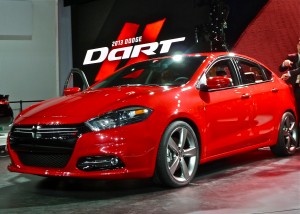
Familiar name in an all-new compact, the stylish Dodge Dart is based on the Alfa Romeo Giuletta platform.
Chevrolet, which recently introduced its new Malibu, unveiled at the show an RS model of its just-released subcompact Sonic, and introduced two other youthful performance cars, the TRU 140S, and the 130R rear-drive coupe. And Cadillac previewed its compact ATS sedan, then displayed at the show its XTS, a sleek sedan that will replace both the departed STS and larger DTS.
The press preview started with Monday morning’s naming of the Hyundai Elantra as 2012 North American Car of the Year, and the Land Rover Range Rover Evoque as North American Truck of the Year. The Elantra amassed 174 points from the 50 jury members, who could apportion 10 voting points among among the three finalists. Second was the Volkswagen Passat at 161, with the Ford Focus third at 155, in one of the closes races in the award’s 19-year history. The Evoque accumulated 254 points, outrunning the Honda CR-V’s 142, and the BMW X3, which placed third with 94 points.
It is the first victory for Land Rover, while Hyundai won with the Genesis two years ago, was runner-up with its iconic Sonata last year, and wins again with the Elantra. John Krafcik, president and CEO of Hyundai of America, vowed the Korean company intends to continue on its current rise, and after the introduction of the sporty new Veloster upgrading to a turbocharged model, and a Genesis coupe with high-tech upgrades, Krafcik said, “Hyundai has become known as a terrific value brand, and we are now becoming a valuable brand.”
But the Domestic Three — formerly known as the Big Three — soon took over the spotlight amid an array of compacts, compact utility, hybrids and futuristic styling concepts. The Fusion was a little bit of all those features, with eye-popping lines, and became arguably the most talked-about introduction at the show, forcing an abrupt transition from displays of the best of the 2012 models to the newest coming vehicles for 2013. Read more


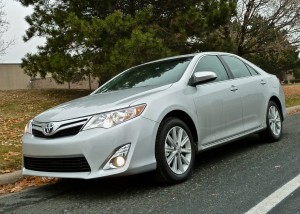
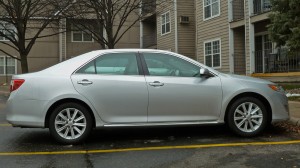
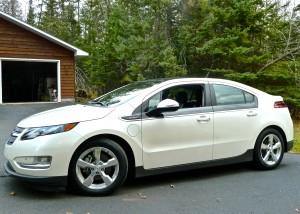
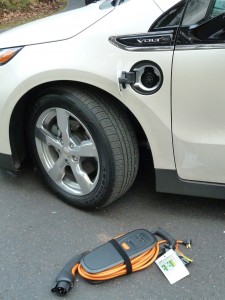

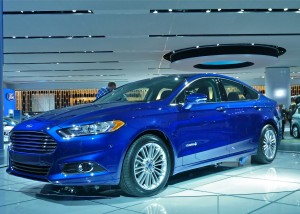
 John Gilbert is a lifetime Minnesotan and career journalist, specializing in cars and sports during and since spending 30 years at the Minneapolis Tribune, now the Star Tribune. More recently, he has continued translating the high-tech world of autos and sharing his passionate insights as a freelance writer/photographer/broadcaster. A member of the prestigious North American Car and Truck of the Year jury since 1993. John can be heard Monday-Friday from 9-11am on 610 KDAL(www.kdal610.com) on the "John Gilbert Show," and writes a column in the Duluth Reader.
John Gilbert is a lifetime Minnesotan and career journalist, specializing in cars and sports during and since spending 30 years at the Minneapolis Tribune, now the Star Tribune. More recently, he has continued translating the high-tech world of autos and sharing his passionate insights as a freelance writer/photographer/broadcaster. A member of the prestigious North American Car and Truck of the Year jury since 1993. John can be heard Monday-Friday from 9-11am on 610 KDAL(www.kdal610.com) on the "John Gilbert Show," and writes a column in the Duluth Reader.